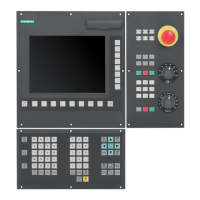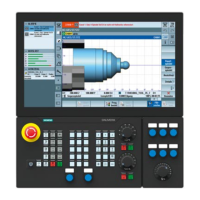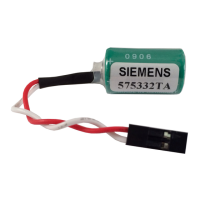Transformations
7.2 Three, four and five axis transformation (TRAORI)
Job planning
7-12 Programming Manual, 03/2006 Edition, 6FC5398-2BP10-1BA0
7.2.2 Three, four and five axis transformation (TRAORI)
Function
The user can configure two or three translatory axes and one rotary axis. The
transformations assume that the rotary axis is orthogonal on the orientation plane.
Orientation of the tool is possible only in the plane perpendicular to the rotary axis. The
transformation supports machine types with movable tool and movable workpiece.
Three- and four-axis transformations are configured and programmed in the same way as
five-axis transformations.
References:
/FB3/ Function Manual, Special Functions; 3- to 5-Axis Transformations (F2)
Programming
TRAORI(n)
or
TRAORI(n,X,Y,Z,A,B)
or
TRAFOOF
Parameter
TRAORI Activates the first specified orientation transformation
TRAORI(n) Activates the orientation transformation specified by n
n The number of the transformation (n = 1 or 2), TRAORI(1)
corresponds to orientation transformation on
X,Y,Z Component of orientation vector to which tool points
A,B Programmable offset for the rotary axes
TRAFOOF Deactivate transformation
Tool orientation
Depending on the orientation direction selected for the tool, the active working plane (G17,
G18, G19) must be set in the NC program in such a way that tool length offset works in the
direction of tool orientation.
Note
When the transformation is enabled, the positional data (X, Y, Z) always relates to the tip of
the tool. Changing the position of the rotary axes involved in the transformation causes so
many compensating movements of the remaining machine axes that the position of the tool
tip is unchanged.

